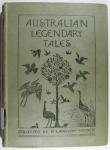Collected by K. Langloh Parker; with introduction by Andrew Lang; illustrations by a native artist, and a specimen of the native text.
Dedication: Dedicated to Peter Hippi, King of the Noongahburrahs.
'I have confined this little book to the legends of the Narran tribe, known among themselves as Noongahburrahs (Preface).
'Author's note: I have dedicated my booklet to Peter Hippi, in grateful recognition of his long and faithful service to myself and my husband, which has extended, with few intervals, over a period of twenty years. He, too, is probably the last king of the Noongaliburrahs, who are fast dying out, and soon their weapons, bartered by them for tobacco or whisky, alone will prove that they ever existed. It seemed to me a pity that some attempt should not be made to collect the folk-lore of the quickly disappearing tribe–a folk-lore embodying, probably, the thoughts, fancies, and beliefs of the genuine aboriginal race, and which, as such, deserves to be, indeed, as Alas Moller says, " might be and ought to be, collected in every part of the world." ' (xi)
 4632736290496020825.jpg
4632736290496020825.jpg
 Australian Legendary Tales : Folk-lore of the Noongahburrahs as Told to the Piccanninies
selected work
Indigenous story
Australian Legendary Tales : Folk-lore of the Noongahburrahs as Told to the Piccanninies
selected work
Indigenous story

